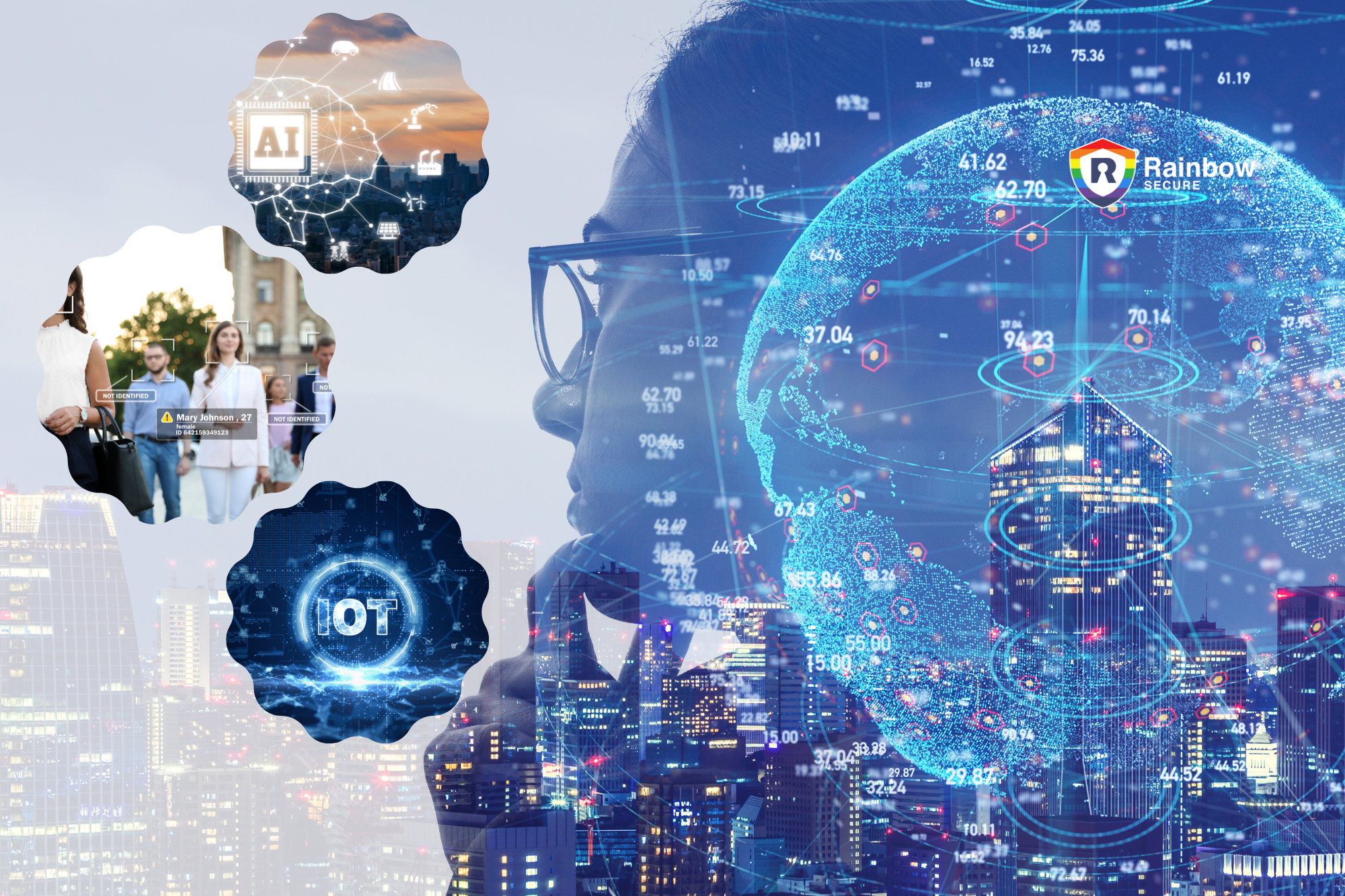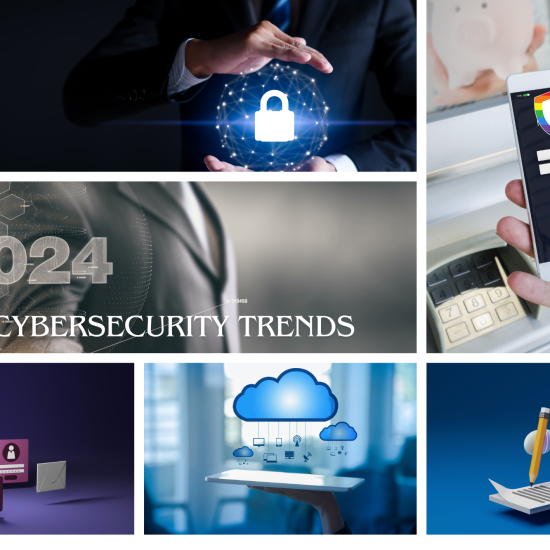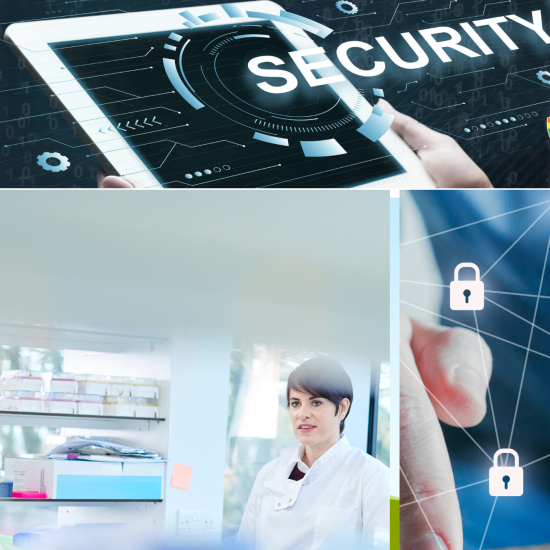Cybersecurity Trends for 2024
As we wrap up 2023, it’s time to take stock of the cybersecurity trends that have emerged throughout the year and plan for what’s ahead. Here are our predictions for 2024 and a peek at the key emerging trends.
- The cost of cyber-attacks on the global economy is set to exceed $10.5 trillion by next year. Cybersecurity must be a strategic priority at all levels – individual, organizational, and governmental – to combat this alarming amount.
- Artificial intelligence (AI) will bring about a revolutionary impact on both attack and defense. The pace of cyber threats has accelerated dramatically in recent years, making it critical to stay informed about upcoming cybersecurity trends.
In this article, you will read about cybersecurity trends for 2024.
1. Enhancing Cybersecurity with AI and Machine Learning
The proliferation of generative AI and machine learning technologies has expanded the possibilities for businesses. However, the increasing complexity and frequency of cyber-attacks demonstrate the need for improved cybersecurity measures. Cybercriminals can now launch sophisticated and stealthy attacks such as deepfakes and self-evolving malware that can compromise systems on a large scale. To counter these advanced threats, enterprises must turn to AI-driven cybersecurity.
AI technology has the potential to revolutionize the cybersecurity industry by improving enterprise posture through the automated hardening of configurations and compliance, overcoming micro-segmentation challenges, fine-tuning least privilege access, and enhancing reporting. It also improves security operations by identifying false positive alerts, detecting advanced attacks like DNS tunneling, and discovering new threat samples.
As threats become more dangerous, companies can consider two distinct methods to uplift their cyber resilience programs. Firstly, cyber insurance is becoming increasingly necessary to protect against the risk of cyber-attacks. Secondly, a centralized visibility dashboard is a tool that many companies will invest in, as it can help plan, track, and react to attacks while providing insights into real-time cyber risks.
In the future, AI and machine learning will be more widely used to protect data across hybrid cloud environments. This includes identifying shadow data, monitoring data access, encrypting data in transit and at rest, and alerting security teams about potential data breaches. User authentication, AI, and machine learning will continue to grow in influence. Leaders can use new technology to help balance security with user experience by analyzing the risk of login attempts, verifying users through behavioral data, biometric data, or multifactor authentication. Additionally, malware can be detected and blocked by analyzing file characteristics, network traffic, user behavior, and other indicators of compromise.
As enterprises embark on this journey, they should prioritize employee education on the secure use of AI tools, ensure security of data transmitted to and from AI tools, have stringent access control and monitoring, and continuously harden models to mitigate potential security vulnerabilities.
The emergence of AI is expected to continue until 2024, and the AI threat will evolve in three stages:
Part I – AI Threat Actors: Human threat actors will increasingly incorporate AI capabilities to enhance their attacks. Weak AI will thrive in 2024, providing an edge for threat actors in specific areas such as discovering vulnerabilities and evading detection. Strong AI, also known as Artificial General Intelligence or Artificial Super Intelligence, will offer a broader and more human-like intelligence and could potentially lead to the emergence of computer-based threat actors.
Part II – New AI Threat Vectors: AI will continue to enhance existing attack vectors such as phishing, vishing, and smishing. It will also create new attack vectors based on the quality of results of generative AI. Early indicators of this potential have materialized in the form of fake news articles, faux legal cases, fake correspondence, and announcements from recognized organizations. These will soon be in the form of videos, vocals, advertisements, and even fake history that will challenge our ability to determine what is real and what is a scam.
Part III – AI Code Assistants: The increased adoption of AI assistants will introduce more errors in software development, such as writing security vulnerabilities into the source code. Developers using AI assistants are more likely to introduce security vulnerabilities than those who don’t rely on AI assistants. Increased use of these tools will also introduce unintentional, AI-generated vulnerabilities and misconfigurations into software products, causing serious security risks.
2. C-Suite Focuses on Cyber Risks and the Emergence of CISOs
The escalation of cyber-attacks and the growing severity of data breaches have compelled C-suite executives to take an active role in cybersecurity decision-making. To meet the higher accountability and penalties for violations, corporate boards will prioritize cybersecurity and may establish exclusive cybersecurity committees, seek outside consultants, and request regular reports from CISOs.
As a result, CISOs, who previously managed tactical risks, enforced compliance, have a more critical role in driving cybersecurity-enabled competitive advantages. CISOs are now included in business strategy decisions and reporting to the board more frequently, with greater autonomy in making investment decisions.
With the board’s dedicated cyber committees and specific C-suite cyber performance metrics, businesses must mandate cybersecurity education and training programs to mitigate cybersecurity risks. They must integrate cybersecurity best practices into any company-wide strategy.
3. The Rise of “Sovereign Cloud” as a Global Business Standard
As data sovereignty laws and initiatives continue to spread across various countries and regions, we predict that the adoption of sovereign cloud will significantly increase in the coming years. With this form of cloud, businesses can safeguard valuable data and systems from unauthorized access, whether on a local or national level. The coverage of these laws is rapidly expanding in an ever-changing landscape of data privacy regulations and geopolitics. By the end of 2023, nearly five billion people responsible for almost 70% of global GDP will fall under a privacy law. Countries are taking strict measures against privacy violations, resulting in significant fines for enterprises, making data sovereignty a crucial priority. By adopting a sovereign cloud solution, organizations can reduce the risk of data breaches, espionage, and sabotage. This will establish trust with investors, customers, and regulators.
The current adoption of sovereign cloud varies depending on the industry, geography, and sector. According to a 2020 survey by IDC, 40% of European organizations have already implemented sovereign cloud solutions, while 31% plan to do so over the next two years. Public sector organizations have a higher adoption rate (49%) than private sector organizations (37%). Also, companies in France (54%) and Germany (51%) have higher adoption rates than those in the UK (29%) or Italy (28%).
Several sovereign cloud solutions like Microsoft’s cloud service, Azure, Government, provides dedicated regions and compliance certifications for US federal, state, local, and tribal government entities and their partners.
4. Managing Cybersecurity Threats in Today’s Digital Age: The Importance of a Continuous Approach and Vendor Consolidation
As our digital ecosystem becomes increasingly complex, so does the likelihood of cyber threats. However, attempting to address every potential threat in an organization’s digital environment is no longer feasible. To combat this challenge, experts recommend that businesses adopt a continuous approach to threat management, including expanding threat assessments to integrated supply chains and consolidating vendors.
To combat the ever-evolving cybersecurity threats, many organizations opt to add more security products and partners. Unfortunately, this approach can make it difficult for them to meet their security objectives. To tackle this issue, an increasing number of businesses are turning to vendor consolidation to bolster their security posture. In fact, 75% of organizations are now pursuing vendor consolidation, up from 29% in 2020. By streamlining their cybersecurity vendor portfolio, businesses can provide their security teams with a more efficient platform to manage risks across a wide range of threats.
5. The Global Shortage of Cybersecurity Professionals: A Growing Concern
With more than 700,000 job openings in the United States alone, the need for cybersecurity professionals has never been more urgent. The demand for skilled individuals in this field is expected to surpass 2.7 million worldwide. The shortage of qualified individuals in this field has led to an increase in cyber threats and incidents, highlighting the importance of hiring qualified personnel to detect, prevent, and respond to these issues.
To address this challenge, companies can consider hiring in-house specialists or outsourcing to external resource companies such as consulting firms and cloud providers. This can help minimize costs and risks associated with cybersecurity. Alternatively, organizations can opt for managed services providers to implement and operate a unified security platform using streamlined, automated processes to strengthen defenses against advanced threats while providing complete visibility into the enterprise’s security posture.
The shortage of skilled cybersecurity professionals is expected to continue through 2024, with a majority (54 percent) of professionals in this field believing that the impact of the skills shortage on their organization has worsened over the last two years. To address this issue, we can expect an increase in salaries paid to those with the necessary skills, as well as greater investment in training, development, and upskilling initiatives.
6. The Advancement of Phishing Attacks
Phishing attacks are expected to increase in complexity, especially those that use social engineering techniques to trick users into giving attackers access to their systems. With the help of Generative AI tools such as ChatGPT, cybercriminals can create more sophisticated and personalized attacks, including deepfake attacks. To address this issue, businesses need to increase awareness and education throughout their organization and implement AI and zero-trust solutions to minimize risk.
7. The Potential Impact of Cyber Attacks on IoT Devices
With the increasing number of internet-connected devices in use, the risk of cyber-attacks is also on the rise. This risk is compounded by the surge in remote work, which has resulted in an increased potential for data sharing over unsecured devices, making them prime targets for cyber criminals. Unfortunately, many IoT devices prioritize convenience over security, and home devices may be particularly vulnerable due to weak security protocols and passwords. Despite the long-standing awareness of IoT security vulnerabilities, the industry has been slow to establish IoT security standards. This makes IoT a target for cyber attackers, but fortunately, the industry is beginning to take action to address this issue.
8. The Significance of Cyber Threats and its Implications
Organizations and governments alike are realizing the potential threats that cyber-attacks pose to national security and economic growth. The possibility of social and political chaos due to massive data breaches is among the reasons why new laws are being created to address cybersecurity concerns.
9. The Progressive Evolution of Zero Trust: From Network Security to Holistic Protection
The basic tenet of zero trust – always verify – has grown in complexity as cybersecurity has become an integral part of business strategies and systems have become increasingly intricate. The fundamental concept is that network activity can no longer be deemed safe within a perimeter. With the ever-expanding threat landscape, this approach now extends beyond the corporate network and into the vast ecosystem of IoT devices, remote workers, and partner organizations. By 2024, zero trust will shift beyond a mere technical network security model and become an adaptive, all-encompassing strategy that employs AI-powered real-time authentication and activity monitoring.
As we’ve reiterated multiple times, being prepared for the future is a crucial aspect of effective risk management – a piece of security advice that remains timeless. Recent studies have demonstrated that enterprises with proactive IT security measures are more successful in thwarting threats, detecting potential security issues, experiencing fewer breaches, and reducing damage from cyber- attacks compared to those with lesser preparation. Dont wait and choose the best for your business to keep it safe and runnning efficiently.
Rainbow Secure plays a pivotal role in fortifying your business against cyber threats. In an era where digital security is no longer optional but a necessity, Rainbow Secure stands as a guardian, offering robust, user-friendly, and compliant security solutions.
Enhanced Security: Rainbow Secure multi-dimensional approach to security, incorporating unique color and style-based authentication, has redefined the meaning of ‘secure login’. By protecting against threats like keyloggers, brute force, and phishing attacks, we ensure that critical infrastructure sector can operate in the digital realm with confidence and peace of mind.
Simplified User Experience: Understanding that complexity is the enemy of security, Rainbow Secure has revolutionized the user experience. Our intuitive and customizable login process not only enhances security but also fosters user engagement and compliance. This ease of use is critical in ensuring that security measures are consistently and effectively implemented across organizations.
Compliance and Regulation: In today’s regulatory landscape, compliance is not just about checking boxes. It’s about protecting reputations, building trust, and ensuring long-term sustainability. Rainbow Secure helps critical infrastructure sector navigate this complex terrain, adhering to stringent standards like GDPR, HIPAA, and NIST, among others. Our commitment to compliance is a testament to our dedication to not just meeting, but exceeding, the highest standards of data protection and privacy.
How can Rainbow Secure help?
Right amount of data and system access to right person or role at right time is the key to organizations being able to use digital tools and platforms to serve the customer base and stay compliant.
Next Generation Rainbow Secure platform is a modern identity authentication (MFA) and single sign- on (SSO) solution for your business across on-premises and cloud environments. It’s backed by an experienced team of cloud and security experts, years of innovation, and partnerships with leading cloud platforms. Rainbow Secure is a Leader in Smart and Secure Digital Solutions that work for you.
Insider Threats: Rainbow Secure assists in mitigating insider threats by implementing access controls, user monitoring, and privilege management solutions. Also, if the user leaves behind unlocked devices, saved passwords in the password manager or browser can be misused by malicious insiders. Interactive login security from Rainbow Secure helps prevents unauthorized access and protects against data theft or misuse by privileged users.
ChatGPT Security for business: Secure your ChatGPT login and Data with Rainbow Secure MFA Plugin.
Secure AI Integration: Consult Rainbow Secure Team to integrate AI in your business workflows powered by Azure and Rainbow Secure API.
Secure Workforce & Customer login: Use Authentication Plug-in by Rainbow Secure to secure workforce and customer logins. In this plug-in, you get a multi-dimensional password, passwordless login solutions with AI monitoring, Risk Analytics, and location fencing.
IoT Friendly Security: IoT platform developers can secure their cloud endpoints, and user logins (both admin and customer) against unauthorized access and scripted malware attacks using easy to adapt and support multi-layer interactive rainbow secure authentication solutions and services that includes but not limited to security assessment, API Security, secure user onboarding, and risk analytics.
Secure Data and its Backups We provide Cloud based data vault and data archive solutions backed by Microsoft Azure and secured by our authentication plugin and industry best practices to give you ransomware protection, help with data governance and disaster mitigation.
Database Security We provide technical consulting services to Secure Databases in cloud and on premise. You get best protection for your data in databases using native and third-party security tools.
Meet Compliance Requirements: Use Authentication Plug-in by Rainbow Secure with your business application and in SSO (Single Sign-on) and meet industry standards and compliance regulations such as NIST, ISO, FTC, SOX, SOC2, CMMC, CMMI, HIPAA, PCI, and others.
Securely communicate and Collaborate: Use Secure Business Email by Rainbow Secure and get protection against account takeover, phishing, ransomware, and automated login cyber frauds. In this email, you get options to send encrypted emails, single sign-on with Office 365, and Google, and 1 TB one drive storage.
Connect Business applications: Get one unified login using Rainbow Secure Single Sign-On
Manage User Onboarding / Offboarding using Rainbow Secure IAM
Verify User using Smart Multi-factor MFA. Smart Multi-Factor Authentication from Rainbow Secure which adjusts to your use case, reduces the cyber liabilities of a business from stolen credentials and improves productivity, and enhances user experience.
Do you have more questions about how Rainbow Secure innovative solutions help to enhance your security posture and safeguard your business from cyber threats and attacks? Contact us today. Email us at Hello@rainbowsecure.com







